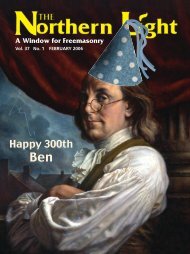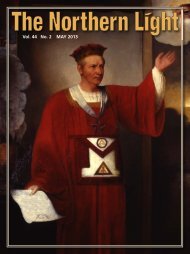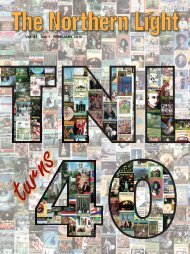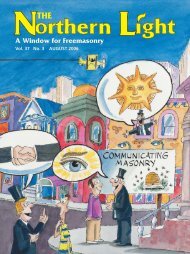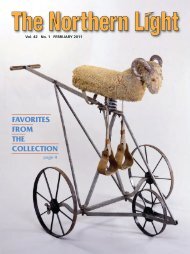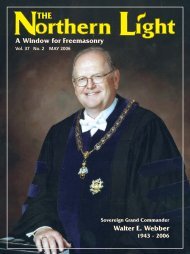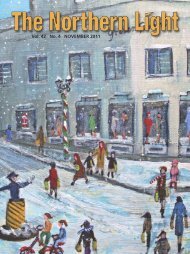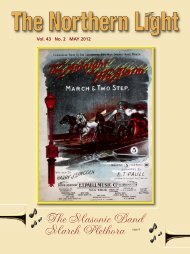The Degree Rituals The Supreme Council, 33 ... - Scottish Rite, NMJ
The Degree Rituals The Supreme Council, 33 ... - Scottish Rite, NMJ
The Degree Rituals The Supreme Council, 33 ... - Scottish Rite, NMJ
Create successful ePaper yourself
Turn your PDF publications into a flip-book with our unique Google optimized e-Paper software.
<strong>The</strong> <strong>Degree</strong> <strong>Rituals</strong><br />
Disobedience - <strong>The</strong> Tenth <strong>Degree</strong><br />
As part of the <strong>Rite</strong> of Perfection, the ritual of the 10° appeared in the<br />
Francken Manuscript under the title “Illustrious Elect of Fifteen.” It was in<br />
the traditional form of degree ritual, with reception, obligation, and explanatory<br />
lecture. In the mid-19th century the ritual was expanded by Albert Pike,<br />
who injected symbolism with philosophical meanings and titled it “Illustrious<br />
Elu of Fifteen.” Although a virtual copy of the Pike ritual was in use after the<br />
Union of 1867, it was superseded in 1871 by a shorter ritual that omitted<br />
much of Pike’s symbolism and adopted the modern title “Master Elect of Fifteen.”<br />
<strong>The</strong> influence of Pike reappeared in the ritual of 1894.<br />
<strong>The</strong> early rituals of the 10°, as those of the 9°, were based on a theme from<br />
the Hiramic legend exemplified in the symbolic lodge; that is, the pursuit and<br />
apprehension of the assassins of Hiram Abif. <strong>The</strong> lesson that pervaded the<br />
various versions of the ritual was obedience to authority. <strong>The</strong> ritual of 1917<br />
dramatized the episode of the assassins in two scenes, which was expanded<br />
to five scenes in the tentative ritual of 1966, in addition to the traditional elements<br />
of the ceremonial section. For some years it had been customary to<br />
present the 10° in conjunction with the 9°, as the rituals of the two degrees<br />
were based on the same theme and the dramatic action from the 9° ritual to<br />
the 10° was continuous.<br />
<strong>The</strong> succession of three tentative rituals proposed for the 10° (as for the<br />
9°) over a span of 15 years from 1965 indicated dissatisfaction with the content<br />
of the ritual and repeated efforts to rework the Hiramic legend and improve<br />
the message. As early as 1943, McIlyar Lichliter had criticized the<br />
rituals of both the 9° and 10° as presenting a version of the Hiramic legend<br />
that differed from that exemplified in the symbolic lodge to which the <strong>Scottish</strong><br />
<strong>Rite</strong> rituals obviously were intended to relate. <strong>The</strong> primary author of the tentative<br />
rituals was Ill. William H. Cantwell, <strong>33</strong>°, Active Member for Delaware,<br />
a member and one time chairman of the Committee on <strong>Rituals</strong>. Cantwell’s efforts<br />
culminated in a short-lived attempt to combine the ritual of the 9° with<br />
that of the 10° into a single ritual which was approved by the <strong>Supreme</strong> <strong>Council</strong><br />
as the 9° and 10° Tentative Ritual of 1980. In the event the combined ritual<br />
never was issued. By this time the Committee on <strong>Rituals</strong> was moving to implement<br />
a plan to replace several of the Lodge of Perfection degree rituals,<br />
29




